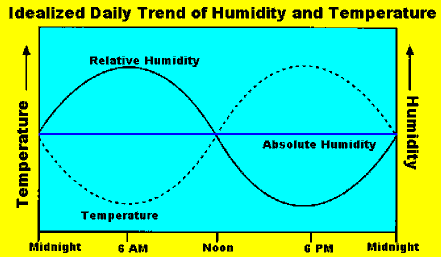 |
 |
| Home | Welcome | What's New | Site Map | Glossary | Weather Doctor Amazon Store | Book Store | Accolades | Email Us |
 | |||||||||
Sometimes It's Relative: HumidityToday's topic looks at humidity, and from the questions I have received over the years, there seems to be a lot of confusion about humidity. We start with water. Under normal Earth conditions, water may exist in one of three states: solid, liquid, or gas. Solid water we call ice; liquid water we just call water. Gaseous water we call water vapour, or when found in the mixture we call air, it is also termed humidity. Humidity, according to meteorologists, can be absolute or relative, giving us the terms absolute humidity and relative humidity. (A third type specific humidity, which has good technical uses, is also defined by meteorologists as a mass ratio, expressed as grams of water vapour per kilogram of humid air. There are .) In our high-paced media world, the adjective is often dropped, and the speaker (or writer) just says "humidity," expecting us to know which they are speaking of. Weathercasters, including those formally trained in meteorology, are often the worst offenders (mia culpa, too). Absolute humidity is defined as the mass of water vapour contained in a volume of air, that is, the density of water vapour, generally expressed as grams per cubic metre. It is like saying there are X grams of cashews in a jar of mixed nuts (too darn few!). Absolute humidity is commonly used by meteorologists because it varies only moderately through an air mass, being added mainly by evaporation or subtracted by condensation, or altered by mixing along the air mass edges. Relative humidity is the dimensionless ratio between the absolute humidity and the saturation absolute humidity for the ambient temperature. (Technically, relative humidity is the ratio between the water vapour pressure in the air and the saturation vapour pressure for the air temperature, but under normal surface conditions, it is well represented by other expressions of absolute humidity.) While I will distinguish here between relative humidity and absolute humidity, I will take one shortcut and refer to air containing water vapour simply as air rather than as humid air. Relative humidity is usually what the media mean when they say "humidity." Relative humidity has uses in human comfort determination and many areas of biometeorology, but it can be a confusing measure because its value varies through the day with the air temperature. For example, the morning may have a relative humidity of 78 percent which by afternoon drops to 53 percent as the air temperature rises. The absolute humidity for that day, however, remained unchanged.  Similarly in winter, the outdoor relative humidity may be 63 percent but when outdoor air permeates our warm homes and offices, the relative humidity level may drop to 35 percent or lower. In this example, the absolute humidity is quite low in the outdoor air, but the saturation value for cold air is also low, and thus, the outdoor air is more humid, relatively speaking. The key term in the relative humidity definition is saturation. Saturation is defined as the condition when the partial pressure of water vapour in the atmosphere is at its maximum level for the existing ambient temperature and pressure. At saturation, equilibrium exists between water vapour and liquid water, and there is no net evaporation or condensation. Given the temperature of a volume of air and its pressure, we can determine the saturation value in any form required. You will often hear saturation called the condition where the air contains "all the water vapour that it can hold." This, however, is not technically correct . We can saturate a parcel of air by adding more water vapour to it (through evaporation or mixing with another parcel of more humid air), or by cooling the parcel down to its saturation temperature. Both processes are at work continually in the atmosphere, but the latter is more familiar to us as it forms fog or dew (or frost if cold enough). The saturation temperature of the ambient air is commonly called the dew point temperature or simply the dew point. Its value is solely dependent on the absolute humidity of the air. You might hear a weathercaster or meteorologist discuss the dew point of a particular air mass. Since dew point, like the absolute humidity, varies little within an air mass, it is a good indicator measurement of the air mass type. Dew point temperature is a regularly reported element in weather observations while absolute humidity is not. When the ambient air temperature equals the dew point, the relative humidity is 100 percent and the air is saturated. Should the air parcel temperature fall lower, water vapour will begin to condense into very small liquid droplets to form clouds or, at the surface, fog. If the temperature of a surface element such as vegetation or rooftops or car exteriors falls below the dewpoint while most of the surrounding air remains above it, dew forms through the condensation of water vapour onto that surface. And, should the dewpoint temperature be below freezing — now called the frost point temperature or frost point — ice crystals will deposit on the surface. We call this frost. Humidity in the air plays many important roles in the atmosphere, particularly with regard to clouds and precipitation formation. The concepts given here will return often in our look at the science of the sky. Learn More From These Relevant Books
|
|||||||||
 |
To Purchase Notecard, |
Now Available! Order Today! | |
 |
 |
NEW! Now Available in the US! |
The BC Weather Book: |


